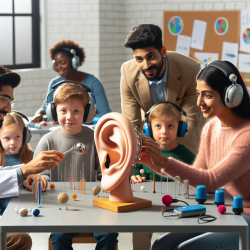The Willeford Binaural Resynthesis Subtest has long been a tool for evaluating central auditory processing capabilities in children. This subtest, part of the Willeford Test Battery (1977), aims to identify brainstem and cortical pathologies by challenging the auditory system's ability to synthesize binaurally presented auditory information. However, recent analysis has raised questions about its efficacy and application, especially in children of elementary school age. Understanding the nuances of this subtest can significantly enhance a practitioner's ability to develop more effective therapeutic interventions and encourage further research in auditory processing disorders.
Recent evaluations of the Willeford Binaural Resynthesis Subtest, involving 56 children with an average age of 8 years and 8 months, have provided insightful data on its characteristics and limitations. The study revealed that a significant portion of the test items fell outside the optimal range for item difficulty, and notable differences were observed between right and left ear scores. Furthermore, a correlation was found between item difficulty and word frequency, suggesting that the test's structure might not be ideally suited for assessing central auditory processing in the target age group.
For practitioners working in special education and speech-language pathology, these findings underscore the importance of selecting and designing auditory processing assessments with a keen understanding of their underlying principles and limitations. Here are several ways practitioners can apply these insights to improve their skills and support further research:
- Consider the Impact of Word Frequency: The correlation between word frequency and item difficulty suggests that frequently occurring words are more easily recognized by children. Practitioners should consider the word frequency of auditory stimuli when designing or selecting assessments to ensure they are appropriately challenging and reflective of the child's linguistic environment.
- Address the Variability in Ear Performance: The significant difference in performance between the right and left ears highlights the need for assessments that can accurately capture this variability. Practitioners might need to employ additional tests or modify existing ones to account for ear-specific differences in auditory processing abilities.
- Optimize Item Difficulty: With many items falling outside the optimal difficulty range, there is a clear need for test adjustments. Practitioners should strive to balance item difficulty to maximize the sensitivity and reliability of auditory processing assessments. This might involve revising the words used or the way auditory information is presented.
- Encourage Further Research: The limitations and questions raised by the evaluation of the Willeford Binaural Resynthesis Subtest underscore the necessity for ongoing research. Practitioners can contribute by participating in studies, sharing clinical observations, and exploring new methods for assessing auditory processing disorders.
By critically examining the tools and methods used to assess auditory processing capabilities, practitioners can significantly enhance the support provided to children with auditory processing disorders. The insights gained from the evaluation of the Willeford Binaural Resynthesis Subtest offer valuable guidance for refining assessment strategies, developing more effective interventions, and paving the way for future research in this critical area of special education and speech-language pathology.
To read the original research paper, please follow this link: Evaluation of the Willeford Binaural Resynthesis Subtest.










